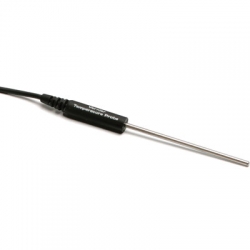
Enlarge

Enlarge
Vernier Stainless Steel Temperature Probe
Order code: TMP-BTA
VERNIER STAINLESS STEEL TEMPERATURE PROBE
Vernier's Stainless Steel Temperature Probe is a rugged, general-purpose temperature sensor with a sealed stainless steel shaft and tip that can be used in organic liquids, salt solutions, acids and bases. Use it as you would use a thermometer for experiments in chemistry, physics, biology, Earth science and environmental science.
Requirements:
This sensor requires suitable software and an interface such as one of the Vernier LabQuest variations or Vernier Go-Link.
For comprehensive details of the possible sensor/interface/software combinations see the Compatibility Guide link below.
Specifications:
• Temperature range: –40 to 135°C (–40 to 275°F)
• Maximum temperature that the sensor can tolerate without damage: 150°C
• Typical Resolution:
0.17°C (–40 to 0°C)
0.03°C (0 to 40°C)
0.1°C (40 to 100°C)
0.25°C (100 to 135°C)
• Temperature sensor: 20 kΩ NTC Thermistor
• Accuracy: ±0.2°C at 0°C and ±0.5°C at 100°C
• Response time (time for 90% change in reading):
10 seconds (in water with stirring)
400 seconds (in still air)
90 seconds (in moving air)
• Probe dimensions:
Probe length (handle plus body): 15.5cm
Stainless steel body: length 10.5cm, diameter 4.0mm
Probe handle: length 5.0cm, diameter 1.25cm
| User Manual | Vernier Stainless Steel Temperature Probe | ||
Educational use only:
Vernier and Kidwind products are designed for educational use. They are not appropriate for industrial, medical or commercial applications. Details
Warranty
- Warranty: 5 year limited warranty
Dimensions- Package size (HxWxD): 13x127x229mm
- Packed weight: 70g
Last edited 9th Jan 2025
 This product is used in teaching these Australian Curriculum codes:
This product is used in teaching these Australian Curriculum codes:
ACSSU187 - Chemical Sciences - Chemical Reactions - Different types of chemical reactions are used to produce a range of products and can occur at different rates
ACSSU189 - Earth and Space Sciences - Global Systems - Global systems, including the carbon cycle, rely on interactions involving the biosphere, lithosphere, hydrosphere and atmosphere
ACSBL019 - Biodiversity and the interconnectedness of life - Describing biodiversity - Ecosystems are diverse, composed of varied habitats and can be described in terms of their component species, species interactions and the abiotic factors that make up the environment
ACSBL021 - Biodiversity and the interconnectedness of life - Describing biodiversity - In addition to biotic factors, abiotic factors including climate and substrate can be used to and classify environments
ACSBL029 - Biodiversity and the interconnectedness of life - Ecosystem dynamics - Models of ecosystem interactions (for example, food webs, successional models) can be used to predict the impact of change and are based on interpretation of and extrapolation from sample data (for example, data derived from ecosystem surveying techniques
ACSBL047 - Cells and multicellular organism - Cells as the basis of life - Factors that affect exchange of materials across membranes include the surface-area-to-volume ratio of the cell, concentration gradients, and the physical and chemical nature of the materials being exchanged
ACSBL046 - Cells and multicellular organism - Cells as the basis of life - Movement of materials across membranes occurs via diffusion, osmosis, active transport and/or endocytosis
ACSBL045 - Cells and multicellular organism - Cells as the basis of life - The cell membrane separates the cell from its surroundings and controls the exchange of materials, including gases, nutrients and wastes, between the cell and its environment
ACSCH039 - Chemical fundamentals - Chemical reactions - A mole is a precisely defined quantity of matter equal to Avogadro’s number of particles; the mole concept and the Law of Conservation of Mass can be used to calculate the mass of reactants and products in a chemical reaction
ACSCH037 - Chemical fundamentals - Chemical reactions - Endothermic and exothermic reactions can be explained in terms of the Law of Conservation of Energy and the breaking and reforming of bonds; heat energy released or absorbed can be represented in thermochemical equations
ACSCH026 - Chemical fundamentals - Properties and structure of materials - Differences in the properties of substances in a mixture, such as particle size, solubility, magnetism, density, electrostatic attraction, melting point and boiling point, can be used to separate them
ACSCH025 - Chemical fundamentals - Properties and structure of materials - Materials are either pure substances with distinct measurable properties (for example, melting and boiling point, reactivity, strength, density) or mixtures with properties dependent on the identity and relative amounts of the substances that make up the
ACSPH069 - Linear Motion and Waves - Waves - Waves may be represented by time and displacement wave diagrams and described in terms of relationships between measurable quantities, including period, amplitude, wavelength, frequency and velocity
ACSCH063 - Molecular interactions and reactions - Aqueous solutions and acidity - The concentration of a solution is defined as the amount of solute divided by the amount of solution; this can be represented in a variety of ways including by the number of moles of the solute per litre of solution (mol L1) and the mass of the solute pe
ACSCH065 - Molecular interactions and reactions - Aqueous solutions and acidity - The solubility of substances in water, including ionic and molecular substances, can be explained by the intermolecular forces between species in the substances and water molecules, and is affected by changes in temperature
ACSCH061 - Molecular interactions and reactions - Aqueous solutions and acidity - Water is a key substance in a range of chemical systems because of its unique properties, including its boiling point, density in solid and liquid phases, surface tension, and ability to act as a solvent
ACSCH060 - Molecular interactions and reactions - Intermolecular forces and gases - The behaviour of gases, including the qualitative relationships between pressure, temperature and volume, can be explained using kinetic theory
ACSCH073 - Molecular interactions and reactions - Rates of chemical reactions - Catalysts, including enzymes and metal nanoparticles, affect the rate of certain reactions by providing an alternative reaction pathway with a reduced activation energy, hence increasing the proportion of collisions that lead to a chemical change
ACSCH069 - Molecular interactions and reactions - Rates of chemical reactions - The rate of chemical reactions can be quantified by measuring the rate of formation of products or the depletion of reactants
ACSCH068 - Molecular interactions and reactions - Rates of chemical reactions - Varying the conditions present during chemical reactions can affect the rate of the reaction and in some cases the identity of the products
ACSPH016 - Thermal nuclear and electrical physics - Heating processes - Heat transfer occurs between and within systems by conduction, convection and/or radiation
ACSPH020 - Thermal nuclear and electrical physics - Heating processes - Provided a substance does not change state, its temperature change is proportional to the amount of energy added to or removed from the substance; the constant of proportionality describes the heat capacity of the substance
ACSPH022 - Thermal nuclear and electrical physics - Heating processes - Two systems in contact transfer energy between particles so that eventually the systems reach the same temperature; that is, they are in thermal equilibrium
ACSCH102 - Equilibrium acids and redox reactions - Chemical equilibrium systems - Volumetric analysis methods involving acidbase reactions rely on the identification of an equivalence point by measuring the associated change in pH, using chemical indicators or pH meters, to reveal an observable end point
ACSBL115 - Maintaining the internal environment - Homeostasis - Animals, whether osmo-regulators or osmo-conformers, and plants, have various mechanisms to maintain water balance that involve structural features, and behavioural, physiological and homeostatic responses
ACSBL111 - Maintaining the internal environment - Homeostasis - Changes in an organism’s metabolic activity, in addition to structural features and changes in physiological processes and behaviour, enable the organism to maintain its internal environment within tolerance limits
ACSBL110 - Maintaining the internal environment - Homeostasis - Homeostasis involves a stimulus response model in which change in external or internal environmental conditions is detected and appropriate responses occur via negative feedback; in vertebrates, receptors and effectors are linked via a control centre by n
ACSCH131 - Structure synthesis and design - Chemical synthesis and design - Chemical synthesis involves the selection of particular reagents to form a product with specific properties (for example, pharmaceuticals, fuels, cosmetics, cleaning products)
ACSCH133 - Structure synthesis and design - Chemical synthesis and design - Designing chemical synthesis processes includes identifying reagents and reaction conditions in order to maximise yield and purity of product
ACSCH132 - Structure synthesis and design - Chemical synthesis and design - Designing chemical synthesis processes involves constructing reaction pathways that may include more than one chemical reaction
ACSCH134 - Structure synthesis and design - Chemical synthesis and design - The yield of a chemical synthesis reaction can be calculated by comparing stoichiometric quantities with actual quantities
ACSCH130 - Structure synthesis and design - Properties and structure of organic materials - Data from analytical techniques, including mass spectrometry, xray crystallography and infrared spectroscopy, can be used to determine the structure of organic molecules, often using evidence from more than one technique
ACSSU095 - Chemical Sciences - Chemical Changes - Changes to materials can be reversible, such as melting, freezing, evaporating; or irreversible, such as burning and rusting
ACSSU149 - Biological Sciences - Cells - Cells are the basic units of living things and have specialised structures and functions
ACSSU176 - Biological Sciences - Ecology - Ecosystems consist of communities of interdependent organisms and abiotic components of the environment; matter and energy flow through these systems
ACSSU179 - Chemical Sciences - Chemical Reactions - Chemical reactions, including combustion and the reactions of acids, are important in both non-living and living systems and involve energy transfer
Click a curriculum code to see other products that relate.
| Works with: | From |
| LABQ2 - Vernier LabQuest 2 Data Logger and Interface | |
| LQ-MINI - Vernier LabQuest Mini Data Logger Interface | $470.00 |
| GA4 - Vernier Graphical Analysis | |
| GO-LINK - Vernier Go!Link Data Logger Interface with Logger Lite Software | $186.00 |
| ESUP - Vernier Electrode Support | $25.00 |
| CHEM-A - Advanced Chemistry with Vernier | $147.00 |
| CWV - Chemistry with Vernier | $147.00 |
| MSV - Middle School Science with Vernier | $147.00 |
| ESI - Vernier Environmental Science through Inquiry | $147.00 |
| BWV - Biology with Vernier | $147.00 |
| CHEM-I - Vernier Investigating Chemistry through Inquiry | $147.00 |
| Similar Products: | From |
| GDX-TMP - Vernier Go Direct Temperature Probe | $196.00 |
| GDX-WRT - Vernier Go Direct Wide Range Temperature Probe | $345.00 |
| GDX-ST - Vernier Go Direct Surface Temperature Sensor | $246.00 |
| GO-TEMP - Vernier Go!Temp Data Logger Temperature Probe with Logger Lite Software | $122.00 |
| GT-TP - Vernier Go!Temp Data Logger Temperature Probe Teacher Pack of 8 | $968.00 |
| STS-BTA - Vernier Surface Temperature Probe | $85.00 |
| TCA-BTA - Vernier Thermocouple | $206.00 |
| TPL-BTA - Vernier Extra Long Temperature Probe | $246.00 |
| WRT-BTA - Vernier Wide Range Temperature Probe | $296.00 |
| EZ-TMP - Vernier Easy Temp | $119.00 |
Note: Prices do NOT include GST or freight


